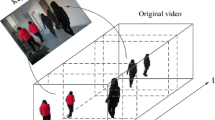Abstract.
In video processing, a common first step is to segment the videos into physical units, generally called shots. A shot is a video segment that consists of one continuous action. In general, these physical units need to be clustered to form more semantically significant units, such as scenes, sequences, programs, etc. This is the so-called story-based video structuring. Automatic video structuring is of great importance for video browsing and retrieval. The shots or scenes are usually described by one or several representative frames, called key-frames. Viewed from a higher level, key frames of some shots might be redundant in terms of semantics. In this paper, we propose automatic solutions to the problems of: (i) video partitioning, (ii) key frame computing, (iii) key frame pruning. For the first problem, an algorithm called “net comparison” is devised. It is accurate and fast because it uses both statistical and spatial information in an image and does not have to process the entire image. For the last two problems, we develop an original image similarity criterion, which considers both spatial layout and detail content in an image. For this purpose, coefficients of wavelet decomposition are used to derive parameter vectors accounting for the above two aspects. The parameters exhibit (quasi-) invariant properties, thus making the algorithm robust for many types of object/camera motions and scaling variances. The novel “seek and spread” strategy used in key frame computing allows us to obtain a large representative range for the key frames. Inter-shot redundancy of the key-frames is suppressed using the same image similarity measure. Experimental results demonstrate the effectiveness and efficiency of our techniques.
Similar content being viewed by others
Author information
Authors and Affiliations
Rights and permissions
About this article
Cite this article
Xiong, W., Lee, CM. & Ma, RH. Automatic video data structuring through shot partitioning and key-frame computing. Machine Vision and Applications 10, 51–65 (1997). https://doi.org/10.1007/s001380050059
Issue Date:
DOI: https://doi.org/10.1007/s001380050059




